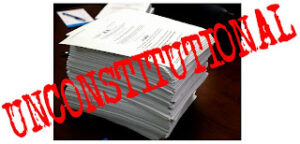As Steve Haner noted in a December 10 post, “Now California Will Control Virginia’s Auto Sales,” the Virginia Air Pollution Control Board (VAPCB) adopted a regulation that places ultimate control of Virginia’s vehicle emission standards in the hands of the California Air Resources Board. Although the VAPCB acted pursuant to a statute enacted by the General Assembly in 2021, the regulation is unconstitutional.
Such a conclusion may seem odd given that the VACPB regulation was issued as a result of ostensibly valid steps. First, the General Assembly has the authority to set vehicle emission standards for Virginia. Second, the General Assembly has the authority to delegate to VAPCB administrative responsibility to implement the vehicle emission standards set by the General Assembly. Third, there does not appear to be any procedural irregularity in the VAPCB’s issuance of the vehicle emission regulation. However, those three actions culminated in a regulation that violates the Virginia Constitution.
Legislative power is vested in the General Assembly. Virginia Constitution, Article IV, Section 1. Although that power is broad, it is not unlimited; the General Assembly’s power to legislate is constrained by the Virginia Constitution and the U.S. Constitution. Terry v. Mazur, 362 S.E.2d 904, 908 (1987).
The General Assembly can delegate legislative powers to executive branch administrative agencies, subject to any “express or necessarily implied prohibitions arising from the Constitution of Virginia or the United States Constitution.” Elizabeth River Crossings OPCO LLC v. Meeks, 749 S.E.2d 176, 188 (2013). Furthermore, “[The Virginia Supreme Court] has uniformly held that the power to exercise legislative authority may not be removed from the control of the local legislative representatives of the people.” County of Fairfax v. Fleet Industrial Park Limited Partbership, 410 S.E.2d 669, 672 (1991). And Virginia officials cannot agree “to contract away, abridge, or weaken any sovereign right” or “barter away, or in any manner abridge or weaken” any of Virginia’s sovereign powers. Taylor v. Northam (Virginia Supreme Court, September 2, 2021) at 23 (citing earlier decisions). See also Elizabeth River Crossings OPCO LCC v. Meeks, 749 S.E. 2d at 194-195 (a statute cannot empower public entities to abridge the Commonwealth’s constitutional police power).
The California Air Resources Board operates under the jurisdiction and control of California law. Under the reasoning of County of Fairfax v. Fleet Industrial Park Limited Partnership, the VAPCB’s regulation is unconstitutional because it removes control of Virginia vehicle emission standards from officials accountable to the people of Virginia and places it in the hands of a California administrative agency.
Furthermore, although the General Assembly can delegate power to the VAPCB to administer vehicle emission standards in Virginia, nothing in the Virginia Supreme Court’s decision in Elizabeth River Crossings OPCO LLC states, suggests, or implies that (1) the General Assembly can delegate legislative powers to executive branch administrative agencies of another State; or (2) the VAPCB can delegate any authority given to it by the General Assembly to an administrative entity in another State. To the contrary, any delegation by the General Assembly or the VAPCB to an administrative agency of another State would fall within a necessarily implied prohibition of the Virginia Constitution. Why? Because any such delegation would have the practical effect of
(a) surrendering a portion of the sovereignty of the people of Virginia (Virginia Constitution, Article I, Section 2; and U.S. Constitution, 10th Amendment) to the control of another State;
(b) giving control of Virginia’s police power over vehicle emissions to another State; and
(c) forcing Virginians to make vehicle purchases constrained by legal standards set by another State, including future amendments and changes made to those legal standards without any consultation with, or consent by, the General Assembly.
The reliance of the General Assembly and VAPCB on Section 177 of the Federal Clean Air Act does not remove their actions from the strictures of the Virginia Constitution. Under U.S. Constitution, Article VI, Clause 2, federal laws enacted pursuant to the U.S. Constitution have supremacy over State law (including State constitutions). However, Section 177 of the Federal Clean Air Act does not require or compel any State to adopt California’s vehicle emission standards. It merely states that a State may decide to follow the example of California with respect to vehicle emission standards, and by doing so a State can avoid having to submit its proposed emission standards to the Environmental Protection Agency for review. Nothing in Section 177 requires a State to make a decision to adopt California’s emission standards in a manner that violates its State constitution.
There is an important legal distinction that the General Assembly and the VAPCB ignored or failed to recognize.
It is not unconstitutional per se for the General Assembly to decide a specific law of another State is worthy of emulation. The General Assembly has the constitutional authority to enact a statute that copies a specific existing statute of another State pertaining to vehicle emission standards. However, the General Assembly has no constitutional authority to enact a statute that (1) gives another State de facto control of Virginia law pertaining to vehicle emission standards, (2) allows future changes in the other State’s regulations on vehicle emission standards to automatically be applied to Virginians without express ratification through the Virginia legislative process to each of the future changes, or (3) is otherwise violative of the Virginia Constitution.
There is no reason to doubt that the General Assembly acted with good intentions when it enacted the 2021 statute to regulate vehicle emissions. But, good intentions and administrative convenience do not justify or excuse legislation that results in a violation of the Virginia Constitution.
Emilio Jaksetic, a retired lawyer, is a Republican in Fairfax County.


Leave a Reply
You must be logged in to post a comment.